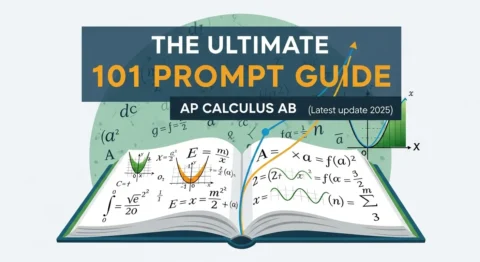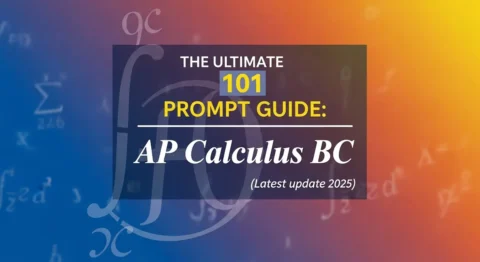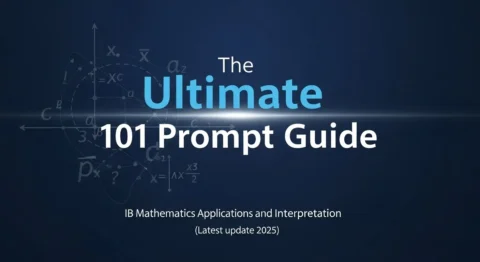Introduction
Welcome to the 101 Prompt Guide for AP Precalculus! This resource is designed to help educators and students leverage the power of Generative AI to master the concepts of AP Precalculus. The prompts are tailored to the official 2024-2025 College Board curriculum, focusing on the four key units: Polynomial and Rational Functions, Exponential and Logarithmic Functions, Trigonometric and Polar Functions, and Functions Involving Parameters, Vectors, and Matrices.
How to Use This Guide: Simply copy and paste the desired prompt into your preferred AI tool (like Gemini, ChatGPT, or Claude). You can modify the prompts by adding specific details or constraints to better suit your needs. For example, you can specify a particular function, a real-world scenario, or a desired output format (e.g., “in a table,” “as a multiple-choice quiz,” “explained for a 10th grader”).
Section 1 – Educator Prompts (50)
A. Planning & Preparation (15 Prompts)
Lesson Plan: Generate a week-long lesson plan for introducing Unit 1: Polynomial and Rational Functions. The plan should include learning objectives, essential questions, activities, and formative assessment ideas, all aligned with the AP Precalculus framework.
Pacing Guide: Create a semester-long pacing guide for an AP Precalculus course, allocating an appropriate number of weeks to each of the four main units and including time for review and exam prep.
Real-World Connections: Brainstorm 5 real-world scenarios that can be modeled using exponential growth and decay functions (Unit 2). For each scenario, describe the context and the key parameters.
Concept Introduction: Design an engaging “hook” or introductory activity to capture student interest in polar coordinates (Unit 3). The activity should be interactive and take about 10 minutes.
Differentiated Instruction: Provide three versions of a worksheet on solving trigonometric equations (Unit 3): one for students who are struggling, one for on-level students, and one for advanced students.
Vocabulary List: Generate a comprehensive vocabulary list with student-friendly definitions for Unit 4: Functions Involving Parameters, Vectors, and Matrices.
Essential Questions: Develop a set of 5 thought-provoking essential questions for the topic of function transformations (Unit 1).
Lab Activity: Design a hands-on lab activity where students can collect data that can be modeled by a sinusoidal function (e.g., pendulum swing, daylight hours) (Unit 3).
Technology Integration: Suggest three ways to effectively use a graphing calculator or online tool like Desmos to explore the properties of rational functions, including asymptotes and holes (Unit 1).
Interleaving Practice: Create a problem set that interleaves concepts from polynomial functions (Unit 1) and logarithmic functions (Unit 2) to promote long-term retention.
Common Misconceptions: Identify and explain three common student misconceptions when working with inverse trigonometric functions (Unit 3) and suggest a strategy to address each one.
Project Idea: Outline a project where students use vectors (Unit 4) to model and analyze a real-world situation, such as airplane navigation or forces in physics.
Flipped Classroom: Create a 5-minute video script explaining the concept of end behavior of polynomial functions (Unit 1), suitable for a flipped classroom model.
Unit Review Guide: Generate a one-page study guide for Unit 2: Exponential and Logarithmic Functions, highlighting key concepts, formulas, and common problem types.
Cross-Unit Connections: Explain the connection between the rate of change in polynomial functions (Unit 1) and the concept of logarithmic scaling (Unit 2).
B. Delivery & Instruction (15 Prompts)
Analogies: Provide three simple analogies to explain the concept of a logarithm to a high school student (Unit 2).
Guided Notes: Create a set of guided notes (fill-in-the-blank style) for a lesson on the properties of logarithms (Unit 2).
Interactive Demo: Describe a step-by-step interactive demonstration using a graphing tool to show how the parameters A, B, C, and D in
y = A sin(B(x - C)) + Dtransform the parent sine function (Unit 3).Think-Pair-Share: Generate three “Think-Pair-Share” questions related to identifying the zeros and multiplicities of polynomial functions from a graph (Unit 1).
Exit Ticket: Create a 3-question exit ticket to quickly assess student understanding of converting equations between polar and rectangular forms (Unit 3).
Socratic Seminar Questions: Develop 5 open-ended questions to facilitate a Socratic seminar on the implications of different function types for modeling real-world phenomena.
Error Analysis: Create a worksheet with 5 solved problems about operations on functions (Unit 1) that contain common errors. Students must identify and correct the errors.
Concept Map: Generate a concept map illustrating the relationships between functions, inverse functions, and their graphs (Unit 1 & 2).
Role-Play Scenario: Create a role-play scenario where one student is a “vector” and must describe their magnitude and direction to another student to reach a target (Unit 4).
Jigsaw Activity: Design a jigsaw activity for trigonometric identities. Divide the main identities (Pythagorean, quotient, reciprocal) into “expert” groups, then have students regroup to teach their peers.
Visual Explanation: Create a simple visual explanation or diagram showing why the end behavior of a rational function is determined by the degrees of the numerator and denominator (Unit 1).
Mathematical Language: Provide sentence stems to help students articulate their reasoning when describing the rate of change of a function over a specific interval.
Peer Tutoring: Generate a short script for a peer tutoring session explaining how to solve a logarithmic equation using the properties of logs (Unit 2).
Code-Based Example: Write a simple Python code snippet that uses a loop to demonstrate the concept of compound interest approaching continuous compounding (Unit 2).
Graphic Organizer: Create a graphic organizer (e.g., a Venn diagram or table) for comparing and contrasting polynomial and exponential functions (Unit 1 & 2).
C. Assessment & Feedback (10 Prompts)
Quiz Creation: Generate a 10-question multiple-choice quiz on Unit 1: Polynomial and Rational Functions. Include an answer key with explanations.
FRQ Design: Design a multi-part free-response question (FRQ) similar to the AP exam format, focusing on a real-world problem modeled by a sinusoidal function (Unit 3). Include a detailed scoring rubric.
Rubric Development: Create a rubric for a project on modeling with functions, assessing criteria like accuracy of the model, clarity of the explanation, and correctness of the mathematical analysis.
Feedback Generation: A student incorrectly identifies a hole in the rational function
f(x) = (x^2 - 4) / (x - 2). Provide constructive feedback that guides the student to the correct understanding of removable discontinuities.Test Correction: Create a test correction worksheet that requires students not only to correct their mistakes but also to explain the concept they misunderstood and find a similar problem to solve correctly.
Performance Task: Design a performance task where students are given a set of data and must determine whether a linear, polynomial, or exponential model is most appropriate, justify their choice, and use the model to make predictions.
Portfolio Prompt: Create a prompt for a student portfolio where they select their “best work” from Unit 4 and write a reflection on their learning process and challenges.
AP-Style MCQs: Generate 5 AP-style multiple-choice questions that require the use of a graphing calculator to solve problems related to vectors and parametric equations (Unit 4).
Peer Review Checklist: Develop a checklist for students to use when peer-reviewing each other’s work on a trigonometric modeling assignment.
Spaced Repetition Quiz: Create a short “retrieval practice” quiz with 5 questions covering key concepts from all four units, designed to be given weekly to support long-term memory.
D. Enrichment & Extension (10 Prompts)
Interdisciplinary Connection: Explain how vectors and matrices (Unit 4) are used in computer graphics and video game design.
Historical Context: Provide a brief historical background on the development of logarithms by John Napier and their importance before the invention of calculators (Unit 2).
Challenge Problem: Create a challenging problem that involves finding the intersection points of a polar rose curve and a circle (Unit 3).
Calculus Preview: Explain how the concept of the average rate of change in precalculus is a foundational idea for the concept of the derivative in calculus.
Real-World Data Analysis: Provide a link to a real-world dataset (e.g., population data, stock prices) and ask students to create a function model, justifying their choice of function type.
Mathematical Modeling: Pose a challenge: “Design a mathematical model using parametric equations to animate a simple object (e.g., a bouncing ball) on a graphing calculator” (Unit 4).
Proof Exploration: Guide students through an informal proof of the Pythagorean identity
sin^2(x) + cos^2(x) = 1using the unit circle definition (Unit 3).Career Connections: List 5 careers that use the concepts from AP Precalculus and briefly explain how (e.g., animator, acoustical engineer, financial analyst).
“What If?” Scenario: Pose a “what if” question: “What if the base of an exponential function was negative? How would its graph and properties change?” (Unit 2).
Independent Research: Generate three potential topics for a student to research that extend beyond the AP Precalculus curriculum but are related to its concepts (e.g., fractals, complex numbers in polar form, matrix transformations in 3D).
Section 2 – Student Prompts (50)
A. Understanding Concepts (15 Prompts)
Explain It Simply: Explain the concept of function composition,
(f o g)(x), as if you were explaining it to a 10th-grade student. Use a real-world example.Key Differences: What is the main difference between an exponential function and a polynomial function in terms of their long-term growth?
Visualizing Concepts: Can you show me a visual representation of the unit circle and explain how it relates to the sine, cosine, and tangent functions?
Conceptual Analogy: Give me an analogy to understand the relationship between polar coordinates (r, θ) and rectangular coordinates (x, y).
Why Does It Work?: Why does the horizontal line test tell us if a function has an inverse that is also a function?
Breaking It Down: Break down the process of finding the vertical and horizontal asymptotes of a rational function into simple, step-by-step instructions.
Summarize: Summarize the key properties of logarithms in a bulleted list.
The “So What?”: Why is the concept of a vector’s magnitude and direction important in physics?
Example Problem: Give me a fully worked-out example of solving a trigonometric equation like
2sin(x) - 1 = 0for all solutions.Define in My Own Words: Help me rephrase the definition of a parametric equation in my own words.
Compare and Contrast: Create a table that compares and contrasts the graphs of
y = sin(x)andy = cos(x).Common Mistakes: What are the most common mistakes students make when applying function transformations?
Big Picture: How does the concept of rate of change connect across different types of functions (linear, polynomial, exponential)?
Mental Model: Help me build a mental model for understanding how the multiplicity of a zero affects the graph of a polynomial at that x-intercept.
Connect to Prior Knowledge: How does the Pythagorean theorem relate to the fundamental trigonometric identity
sin^2(x) + cos^2(x) = 1?
B. Practicing & Applying (15 Prompts)
Practice Problems: Give me 5 practice problems on finding the domain and range of rational functions.
Step-by-Step Solution: Walk me through solving the logarithmic equation:
log_2(x) + log_2(x - 2) = 3.Check My Work: I think the inverse of
f(x) = 2x - 5isg(x) = (x + 5)/2. Can you check my work and let me know if I did it correctly?Create a Problem: Create a word problem that can be solved using the Law of Sines or Law of Cosines.
Function Modeling: I have the following data points: (0, 3), (1, 6), (2, 12), (3, 24). What type of function would best model this data? Help me find the equation.
Graphing Practice: Describe how to graph the function
f(x) = -2(x - 3)^2 + 4using transformations of the parent functiony = x^2.Calculator Skills: How do I use my graphing calculator to find the intersection point of two functions,
y1 = e^xandy2 = -x + 4?Drill Sheet: Generate a drill sheet with 10 problems on converting angles between degrees and radians.
Apply the Formula: Show me how to use the formula for continuous compound interest,
A = Pe^(rt), with a specific example.Vector Operations: Given vectors
u = <2, -3>andv = <1, 5>, walk me through finding2u - vand its magnitude.Parametric Path: The path of a particle is given by
x(t) = 2tandy(t) = t^2 + 1. Is the particle ever at the point (4, 5)? Show me how to figure this out.Find the Error: I tried to simplify
(x^2 + 9) / (x + 3)tox + 3. Is this correct? If not, explain my mistake.Work Backwards: The graph of a polynomial has zeros at x = -1, x = 2, and x = 4. What is a possible equation for this polynomial?
Real-World Application: The temperature in a room is modeled by
T(t) = 72 + 5sin(π/6 * t), where t is hours after noon. What is the temperature at 3 PM? What is the period of this cycle?Matrix Multiplication: Show me the step-by-step process for multiplying a
2x2matrix by a2x1matrix.
C. Revising & Self-Assessment (10 Prompts)
Flashcards: Create a set of 10 digital flashcards for Unit 3: Trigonometric and Polar Functions. The front should have a term or problem, and the back should have the definition or solution.
Self-Quiz: Give me a 5-question quiz on end behavior of polynomial and rational functions. After I answer, tell me if I was right and explain the solutions.
Review Sheet: Generate a “cheat sheet” for the most important trigonometric identities I need to memorize.
Explain It Back: I’m going to explain the process of finding the inverse of a function. Can you tell me if my explanation is clear and correct? [Student types their explanation].
Key Concepts: What are the 3 most important concepts from Unit 2: Exponential and Logarithmic Functions that are most likely to appear on the exam?
Identify My Weakness: I’m struggling with polar functions. Can you ask me 5 questions of increasing difficulty to help me identify my specific weak spots?
Study Plan: Help me create a 3-day study plan to review for my test on Unit 1.
Concept Connections: How are the concepts of zeros, roots, x-intercepts, and solutions related when talking about a polynomial function?
Formula Sheet: Create a personal formula sheet with all the key formulas from Unit 4, including vector operations and parametric motion.
Predict the FRQ: Based on the AP Precalculus curriculum, what is a likely scenario for a free-response question involving function modeling?
D. Preparing for the AP Exam (10 Prompts)
FRQ Strategy: Give me a step-by-step strategy for tackling a free-response question on the AP Precalculus exam, especially the parts that require written explanations.
Time Management: How should I manage my time on the multiple-choice section of the AP exam?
Calculator Tips: What are some advanced calculator tricks (for TI-84 or similar) that could save me time on the exam, especially for graphing polar functions or finding roots?
Simulate a Question: Act as an AP exam proctor. Give me one calculator-active multiple-choice question and give me 90 seconds to answer it. Then, reveal the answer and explanation.
Common Pitfalls: What are the most common “trap” answers in multiple-choice questions related to function transformations?
Justification Practice: The prompt asks me to “justify my answer.” Give me 3 examples of strong vs. weak justifications for a problem involving asymptotes.
Full Exam Review: Create a “final boss” review sheet that has one challenging problem from each of the four main units of the course.
Vocabulary for FRQs: What specific mathematical vocabulary should I use in my FRQ explanations to earn full points?
Mock FRQ: Give me a mock free-response question that combines concepts of exponential functions and rates of change. After I provide my answer, give me feedback based on a 9-point AP rubric.
Confidence Booster: I’m nervous about the exam. Can you give me a summary of the key skills I’ve learned in AP Precalculus to remind me of how much I’ve accomplished?
Section 3 – Bonus Universal Prompt (1)
Creative Modeling Challenge:
(For Educators): “Design a project titled ‘The Art and Math of Motion.’ Students must choose a piece of music and use parametric and polar equations to create a dynamic, animated visualization (using Desmos or another graphing tool) that represents the rhythm, tempo, and mood of the song. The project should include a written analysis explaining how their mathematical choices connect to the musical elements. Provide a rubric for this project.”
(For Students): “I want to create an animation set to my favorite song using math. My song is [insert song title and artist]. Help me brainstorm ideas for using parametric and polar equations to represent the song’s beat, melody, and feeling. What kinds of shapes and movements could I use to represent a slow chorus or a fast-paced bridge? Show me some example equations I could start with.”





